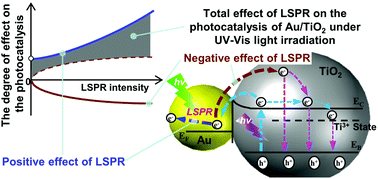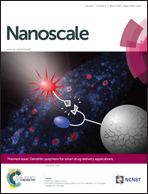On the role of localized surface plasmon resonance in UV-Vis light irradiated Au/TiO2 photocatalysis systems: pros and cons†
Abstract
The role of localized surface plasmon resonance (LSPR) in UV-Vis light irradiated Au/TiO2 photocatalysis systems has been investigated, and it is demonstrated experimentally for the first time that both pros and cons of LSPR exist simultaneously for this photocatalytic reaction. We have proved that when operating under mixed UV and green light irradiation, the LSPR injected hot electrons (from the Au nanoparticles to TiO2 under green light irradiation) may surmount the Schottky barrier (SB) formed between the Au nanoparticles and TiO2, and flow back into the TiO2. As a result, these electrons may compensate for and even surpass those transferred from TiO2 to the Au nanoparticles, thus accelerating the recombination of UV excited electron–hole pairs in TiO2. This is the negative effect of LSPR. On the other hand, more hot electrons existing on the surface of the Au nanoparticles due to LSPR would favor the photocatalytic reaction, which accompanied by the negative effect dominates the overall photocatalytic performance. The presented results reveal the multi-faceted essence of LSPR in Au/TiO2 structures, and is instructive for the application of metal-semiconductor composites in photocatalysis. Moreover, it is confirmed that the extent to which the above pros and cons of LSPR dominate the overall photocatalytic reaction depends on the intensity ratio of visible to UV light.


 Please wait while we load your content...
Please wait while we load your content...